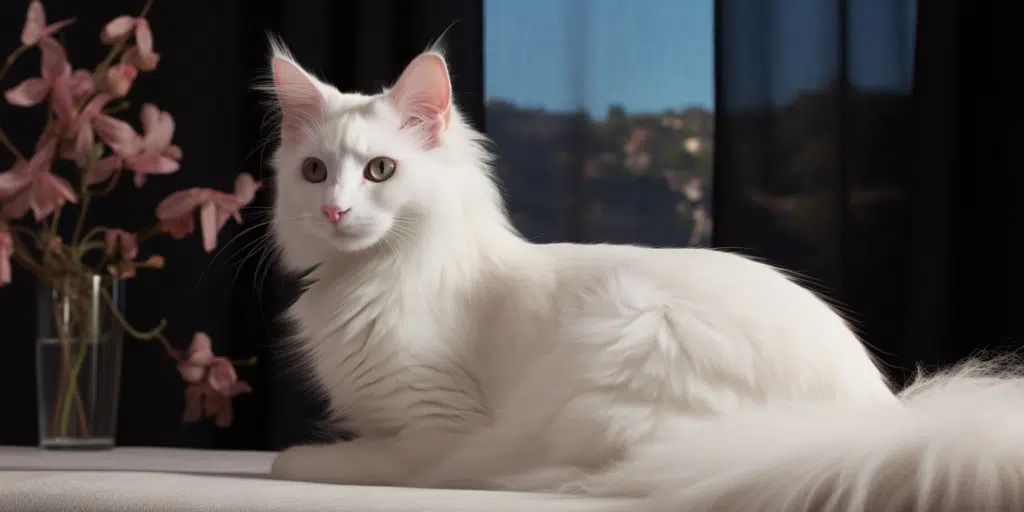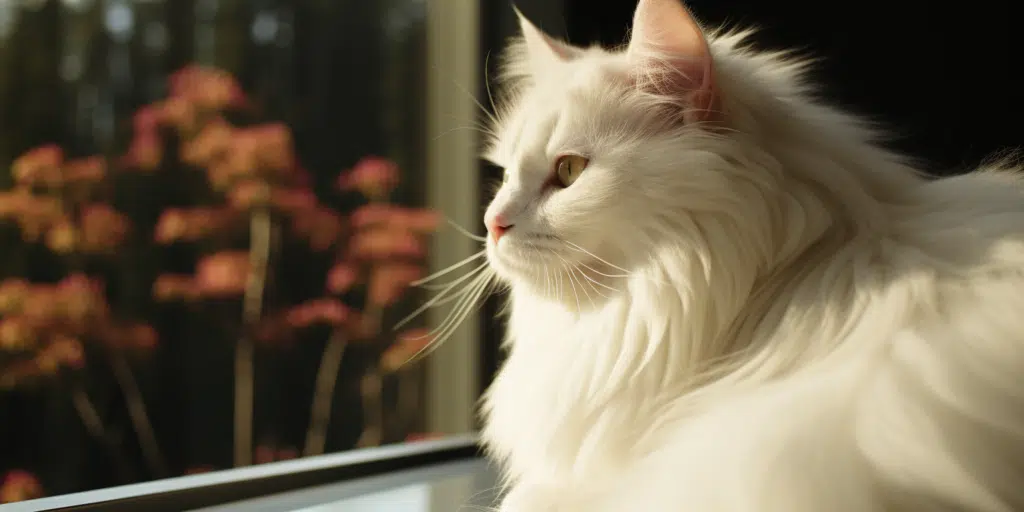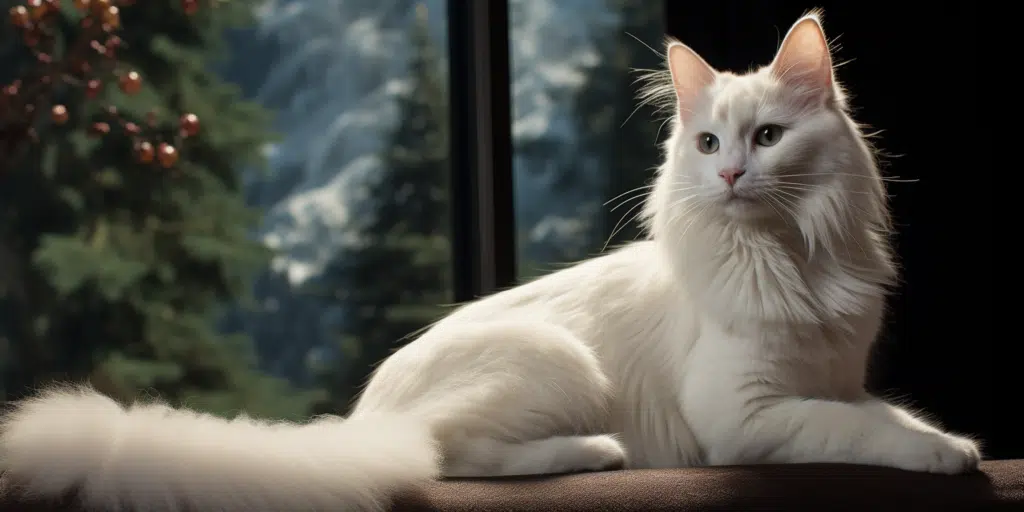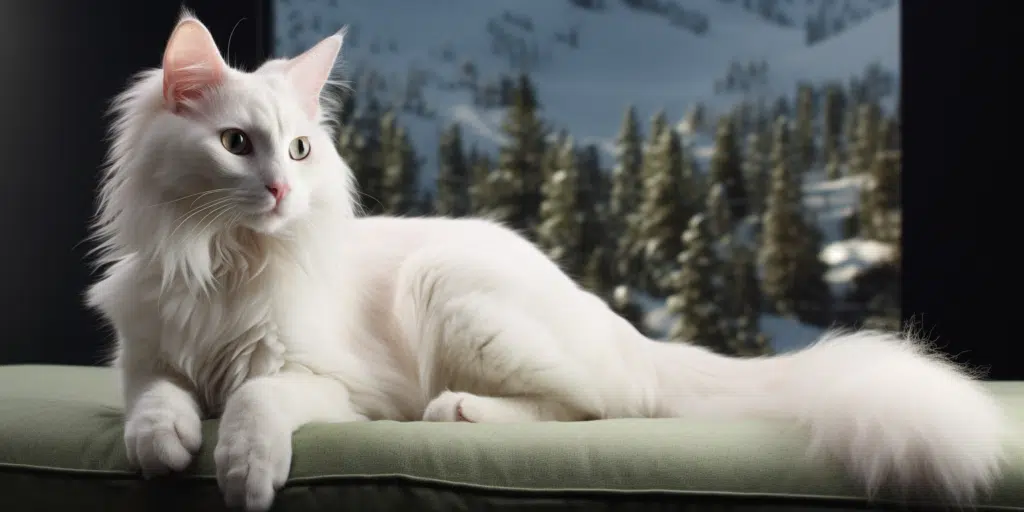The graceful and elegant Turkish Angora is a cat breed that has captured the hearts of many feline enthusiasts across the globe. With their silky fur, large, expressive eyes, and playful personalities, these cats are not just beautiful; they’re also a source of endless delight for their owners.
The male vs female Turkish Angoras differences aren’t just about gender; they can also influence the pet’s behavior, health, and compatibility with your household.
In this blog, we will delve into the key differences between a male and a Female Turkish Angora, providing insights into each gender’s characteristics to help you make an informed decision.

Visual Differences
| Male | Female | |
|---|---|---|
| Average height (adult): | 9 – 14 inches | 9 – 14 inches |
| Average weight (adult): | 8 – 15 pounds | 8 – 12 pounds |
| Lifespan: | 12 – 18 years | 12 – 18 years |
| Energy Level: | High | High |
| Grooming needs: | Moderate to High | Moderate to High |
| Family-friendly: | Friendly | Friendly |
| Other pet-friendly: | Often | Often |
| Trainability: | Moderate | Moderate |
Male Breed Overview
When you look at male Turkish Angoras, you’ll notice a few key characteristics that often set them apart from females. Typically, males of this breed tend to be larger with a more robust build. Their personalities are also something to note, as males can be more assertive and territorial. These behaviors are typically more pronounced in unneutered cats but can be managed with early socialization and proper training.
Male Turkish Angoras often exhibit a playful and outgoing nature, making them wonderful companions for those seeking an interactive pet. They may be more likely to engage in play and exhibit a higher energy level throughout their lives compared to females. It’s crucial for potential owners to provide ample stimulation through toys, playtime, and attention to cater to these energetic needs.
On the social side of things, male Turkish Angoras are known to form strong bonds with their families. They may demand more attention and can sometimes have a clownish attitude, often entertaining their human companions with their antics. Despite their independence, they do not enjoy being left alone for prolonged periods and thrive in environments where they have company most of the time.

Training A Male
Training a male Turkish Angora can be an enjoyable experience due to their intelligent and curious nature. They are responsive to positive reinforcement techniques such as treats and praises. Males might occasionally exhibit a stubborn streak but remain capable learners who enjoy interactive and mentally stimulating training sessions.
Early socialization is key in shaping a well-adjusted adult Turkish Angora. Introducing a male kitten to various people, pets, and environments can help reduce territorial behavior as they grow. Consistency in training is crucial, as males may try to assert dominance without clear boundaries and guidelines from their owners.
Moreover, toilet training is typically straightforward for Turkish Angoras due to their clean habits. It’s recommended to start training as early as possible to establish good routines and consistency.
Health & Care
The Turkish Angora is generally a healthy breed, but like all animals, males have specific health and care needs. Neutering is recommended not only to prevent unwanted litters but also to reduce the likelihood of certain behaviors such as roaming, aggression, and marking territories within the home.
Regular veterinary check-ups are essential for maintaining good health. Besides neutering, male Turkish Angoras should be monitored for genetic conditions such as hypertrophic cardiomyopathy (HCM), a common heart disease in cats. Ensuring they maintain a healthy weight is also vital since obesity can lead to various health issues.
Their long, fine coats require regular grooming to prevent matting. A routine brushing several times a week is necessary for removing loose hair and distributing skin oils evenly along the length of their coat. Males may require more frequent grooming during seasonal shedding periods.

Suitable for:
Male Turkish Angoras are suitable for families looking for an interactive pet who will be an integral part of daily life. They do well in homes where they receive plenty of attention and mental stimulation, making them excellent companions for individuals or families with time to invest in play and interaction.
Their social nature means they often get along with other pets, including dogs and other cats, which makes them great additions to multi-pet households. Males can adapt well to apartment living as long as their exercise needs are met through indoor play. They are also suitable for larger homes with safe outdoor access.
Female Breed Overview
Female Turkish Angoras have their distinct characteristics that may appeal to certain cat owners. They are generally smaller in size compared to males with a more delicate bone structure. Females can be as playful as males but often exhibit a more independent demeanor, which might make them seem less demanding of attention at times.
Female Turkish Angoras maintain much of the breed’s characteristic elegance and grace. While they may bond closely with their owners, their affections are often displayed on their own terms. Females can be loving but might prefer quieter interactions such as sitting beside you rather than on your lap.
Another point worth mentioning is that females may become more territorial during their heat cycles if they are not spayed. Therefore, spaying is highly recommended not only for avoiding unwanted kittens but also for reducing potential behavioral issues linked to their reproductive cycle.

Training A Female
Training female Turkish Angoras also relies on positive reinforcement techniques; however, their independent nature might require a little more patience. Like males, females respond well to treats and affection when they perform desired behaviors or learn new tricks.
Females can benefit significantly from early socialization too since it helps prevent them from becoming overly shy or reserved. Introduce them early on to various household environments so they feel comfortable throughout different spaces.
While female Turkish Angoras can be slightly less demanding than males when it comes to playtime, this does not mean they don’t need regular mental stimulation. Keep them engaged with puzzle feeders or toys that challenge their intellect.
Health & Care
For female Turkish Angoras, spaying is an essential aspect of their care regime. It not only prevents unwanted pregnancies but also reduces the risk of mammary tumors and ovarian cancers as they age. Monitoring their health through regular vet visits is crucial in catching any issues early on.
Females share similar grooming needs with males; however, some owners report that females shed somewhat less than males do—although this can vary from cat to cat. Regardless, a regular grooming routine is necessary to keep their coat looking its best.
Particular attention should be paid to dental care and maintaining a balanced diet that supports their more petite build without contributing to weight gain.

Suitable for:
Female Turkish Angoras make ideal pets for owners who appreciate a cat with an independent streak while still enjoying interactive playtime sessions. They are suitable for individuals or families who respect their need for space at times yet seek a loyal and graceful companion.
Females can adapt well both in homes with other pets or as single pets, where they might revel in being the center of attention. Their suitability extends from small apartments to larger houses so long as their physical and mental needs are met.
Which One Is Right for You?
Deciding whether a male or female Turkish Angora is right for you will heavily rely on personal preference and lifestyle compatibility. While both genders share many breed traits, such as intelligence and playfulness, subtle differences in size, temperament, and care requirements may influence your decision.
Consider your household dynamics. Do you desire an interactive and perhaps more demanding pet? A male might suit you best. Alternatively, if you’re looking for a more independent cat that values her quiet time as much as her playtime, then a female may be the perfect match.

Conclusion
Both male and female Turkish Angoras bring their unique charm and characteristics into any home. While it’s important to understand the general tendencies of each gender within this breed, it’s equally important to remember that every cat is an individual with its personality quirks and habits.
When choosing between Male vs Female Turkish Angoras, consider your expectations from pet ownership and your environment. No matter which gender you choose, these enchanting cats will surely provide companionship, beauty, and joy for years to come.
Just remember that love, care, and understanding go a long way in forging a lasting bond with your chosen feline friend—male or female.